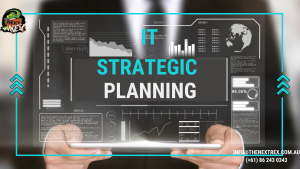Creating an effective IT strategy and planning is crucial for businesses in today’s fast-paced digital landscape. An IT strategic plan serves as a roadmap, aligning technology initiatives with organizational goals. This comprehensive approach ensures that Information Technology (IT) resources are utilized efficiently, promoting growth and innovation. In this article, we’ll delve into the significance of an IT strategic plan, its components, and steps to develop an effective strategy for seamless operations and sustained success.
Significance of IT Strategy and Planning

IT Strategic Planning Overview: An IT strategic plan is the blueprint guiding how technology will support the organization’s objectives. It involves analyzing current technological capabilities, identifying future needs, and charting a course to bridge the gap effectively.
Aligning Technology with Business Goals:
An effective information technology strategic plan ensures that technological investments align with the broader business strategy. By understanding organizational objectives, IT leaders can prioritize initiatives that directly contribute to achieving these goals.
Optimizing Resource Allocation:
With a well-defined IT strategic plan, resources—both human and technological—can be allocated optimally. This prevents unnecessary expenditures and enhances productivity.
Enhanced Agility and Innovation:
A robust IT strategy enables organizations to adapt swiftly to market changes and embrace emerging technologies. It fosters innovation by creating an environment conducive to experimentation and growth.
Components of an IT Strategic Plan

Assessment of Current State:
Conducting a comprehensive assessment of existing IT infrastructure, processes, and capabilities is the initial step. This evaluation helps in identifying strengths, weaknesses, opportunities, and threats (SWOT analysis) to form the foundation of the strategic plan.
Defining Objectives and Goals:
Clear and measurable objectives aligned with the organization’s mission are essential. These goals should be specific, achievable, relevant, and time-bound (SMART) to guide decision-making and resource allocation.
Risk Management and Contingency Plans:
Anticipating and mitigating potential risks is critical. Developing contingency plans ensures resilience against unforeseen challenges, safeguarding operations and data.
Technology Roadmap:
Creating a roadmap outlining the implementation of new technologies and upgrades is pivotal. This roadmap should detail timelines, responsible stakeholders, and expected outcomes.
Budget and Resource Allocation:
Allocating resources and budget in accordance with the strategic objectives ensures effective execution. Prioritizing initiatives based on their strategic importance is key to optimal resource utilization.
Steps to Develop an Effective IT Strategy
Gather Stakeholder Input: Involving key stakeholders from various departments ensures alignment between IT initiatives and organizational objectives.
Conduct a Comprehensive Analysis:
Analyze market trends, technological advancements, and competitors’ strategies to identify opportunities and threats.
Define Clear Objectives:
Establish specific and measurable objectives that address both short-term and long-term organizational needs.
Create an Actionable Plan:
Develop a detailed plan outlining the steps, resources, timelines, and responsibilities necessary for implementation.
Regular Review and Adaptation:
Continuously assess and adapt the IT strategy to accommodate evolving business needs and technological advancements.
In conclusion, an effective IT strategic planning serves as a cornerstone for organizational success in today’s digital age. By aligning technology initiatives with business objectives, optimizing resource allocation, and fostering innovation, businesses can navigate challenges and capitalize on opportunities, staying ahead in the competitive landscape. Implementing a robust IT strategy is not just a choice; it’s a necessity for sustainable growth and resilience in a dynamic market environment.
Here are some FAQs (Frequently Asked Questions) on IT Strategy and Planning:
Q1: What is IT strategy and planning, and why is it important for businesses?
A: IT strategy and planning involve the formulation of a roadmap that aligns technology initiatives with organizational goals. It is crucial for businesses as it ensures optimal use of resources, supports business objectives, enhances agility, and fosters innovation in a rapidly evolving digital landscape.
Q2: What does a powerful IT strategic plan encompass?
A: An effective IT strategic plan comprises several components, including a thorough assessment of the current IT infrastructure, clear objectives aligned with the organization’s mission, risk management strategies, technology roadmap, and resource allocation plans. It aims to guide decision-making and resource utilization in the IT domain.
Q3: How does IT strategy contribute to the overall success of an organization?
A: IT strategy plays a pivotal role in organizational success by ensuring that technological investments align with broader business strategies. It enhances efficiency, supports growth, enables swift adaptation to market changes, and promotes a culture of innovation within the organization.
Q4: What are the steps followed in developing a robust IT strategy?
A: Developing a robust IT strategy involves various steps such as gathering stakeholder input, conducting comprehensive analysis, defining clear objectives, creating an actionable plan, and ensuring regular review and adaptation. This iterative process helps in aligning IT initiatives with the evolving needs of the business.
Q5: How can businesses measure the success of their IT strategic plan?
A: The success of an IT strategic plan can be measured by assessing its alignment with organizational goals, the efficiency of resource utilization, the ability to adapt to changing market dynamics, successful implementation of technology upgrades, and the overall impact on enhancing business performance.
Q6: What are the common challenges faced in implementing an IT strategic plan?
A: Challenges in implementing an IT strategic plan may include resistance to change, insufficient budget allocation, inadequate technological expertise, lack of stakeholder buy-in, and difficulties in keeping up with rapid technological advancements. Addressing these challenges requires proactive planning and effective communication.
Q7: How often should an IT strategic plan be reviewed or updated?
A: IT strategic plans should be reviewed regularly, preferably annually, or more frequently if there are significant shifts in the business environment or technology landscape. Regular reviews ensure that the plan remains relevant, adaptable, and aligned with the organization’s evolving goals.
Q8: What are the key benefits of a well-executed IT strategy and planning process?
A: A well-executed IT strategy and planning process contribute to increased operational efficiency, cost savings through optimized resource allocation, enhanced competitiveness, improved customer satisfaction, streamlined workflows, and better utilization of emerging technologies for business advantage.

